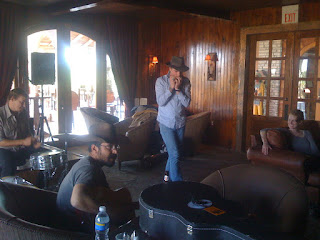As a performing songwriter, I am expected to be a troubadour as well, traveling from town to town, serenading strangers in different settings. But driving from town to town is not so green. Nor is it cheap. I sat down and did the math for a performance I had scheduled last weekend in Far West Texas, one of the most remote regions in the country. The truth in the math suggested to me that I should cancel the gig. Why ? The round trip in my red Volvo, “Ruby”, would cost me about the same in gasoline as I was getting paid for the gig. And driving solo all the way across Texas is the sort of guilt which keeps me awake at night. Not wanting to let down the venue or lose work ethic points, I was determined to find a solution.
Amtrak services the Big Bend area, but from Austin, it is $150 round trip and includes a 9 hour layover in San Antonio overnight...making the total journey over 50 hours long on the train ( vs 16 hours round trip in a car ). There is no bus that goes out to Big Bend from Austin and no mass transit of any kind once there in the area.
So the only answer was to find drivers already heading that way.
I had participated in many
rideshares before, but only between major cities, and never for a gig where I needed to haul my guitar and other related paraphernalia. I
wasn’t quite sure how I was going to pull this off. I closed my eyes and thought about all the vehicles whizzing around everywhere with all their empty seats. Surely I could do this. The adventurer within was awakened.
The first part was easy. I got on
craigslist and searched the
rideshare ads. Luck struck ! There was a driver heading out West from Austin Texas to
Marfa, TX for a Film Festival. I contacted her. Even though her email alias was tagged as “Creepy”, I took a chance. I attributed the name choice to the Greenland/Iceland reverse psychology theory. She turned out to be rather normal, not overly normal, and a very good driver. The other passenger and I had some friends in common. After our
rideshare team was assembled, we headed out west. The trip to Alpine cost us each $13 in gas in her Toyota Corolla, and placed me within 80 miles of my final destination. My Volvo would have charged me close to $60 each way if I had driven these 400 miles solo. Ruby demands premium gasoline. I have tried to trick her a few times, but she knew the difference and did not react kindly.
In Alpine, I stood on Hwy 118 and stuck out my thumb. Hitchhiking is technically illegal in Texas, but when the sheriff drove by, he smiled and waved. A new red pick up truck pulled over. Kaleb told me that he had seen me perform in
Terlingua before and offered me a ride. After he dropped me off about 15 miles from
Terlingua, I accosted the mailman. He told me he was heading into town, and so I rode with him to
Terlingua. Once in
Terlingua, I got lucky again and encountered the bartender of the “Thirsty Goat” in
Lajitas, the bar I was playing in that night. Against the will of the drivers, I pitched in for gas for these shorter journeys to help the drivers a bit with their guzzlers. All in all, I got from Austin, Texas to
Lajitas for $22.
In addition to the savings and free adventure, my final reward came from a very appreciative gentleman in the audience who started throwing $100 bills in my tip jar. No Joke !
Yes, it pays to travel green.
 Happy Hanukkah, Chanukah, Hanukah, Hannukah, Chanuka, Chanukkah, Hanuka, Channukah, Chanuka, Hanukka, Hannuka, Hannukkah, Channuka, Xanuka, Channukkah, Channukka, and Chanuqa.
Happy Hanukkah, Chanukah, Hanukah, Hannukah, Chanuka, Chanukkah, Hanuka, Channukah, Chanuka, Hanukka, Hannuka, Hannukkah, Channuka, Xanuka, Channukkah, Channukka, and Chanuqa.
















 on a muddy road. It'll take a couple of sunny days for the mud to dry out before I could get her home. I tried to beat an approaching storm when visiting my neighbor to pick up a 5 watt light bulb. I got to his house, but when trying to head back after giant raindrops started bombarding the ground, I didn’t get far. As a result, John Wells, my neighbor, had an unexpected house mate for the night as the road out from his house to the highway is unforgiving when it storms. The next morning, I walked the two and half miles out to the highway as the mud clung desperately to my shoes. Soon after I found out that bare feet was easier, John’s neighbor, James Kirk zoomed by on his tractor and lifted me back home.
on a muddy road. It'll take a couple of sunny days for the mud to dry out before I could get her home. I tried to beat an approaching storm when visiting my neighbor to pick up a 5 watt light bulb. I got to his house, but when trying to head back after giant raindrops started bombarding the ground, I didn’t get far. As a result, John Wells, my neighbor, had an unexpected house mate for the night as the road out from his house to the highway is unforgiving when it storms. The next morning, I walked the two and half miles out to the highway as the mud clung desperately to my shoes. Soon after I found out that bare feet was easier, John’s neighbor, James Kirk zoomed by on his tractor and lifted me back home.





























